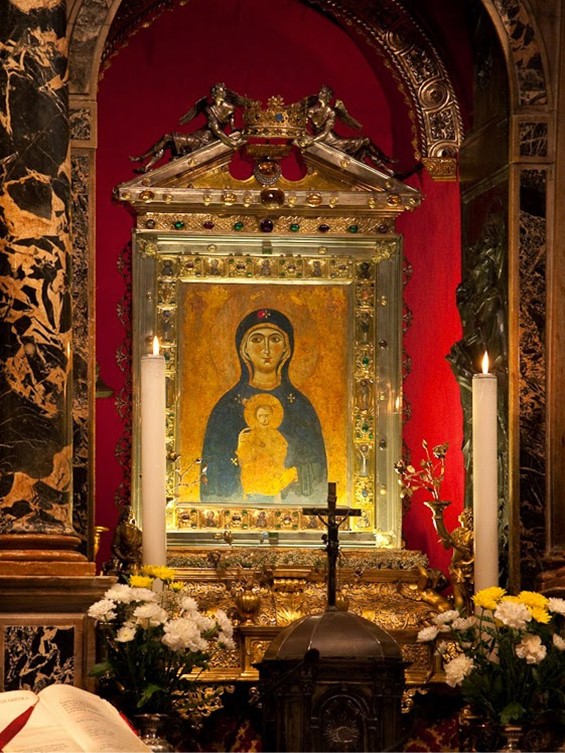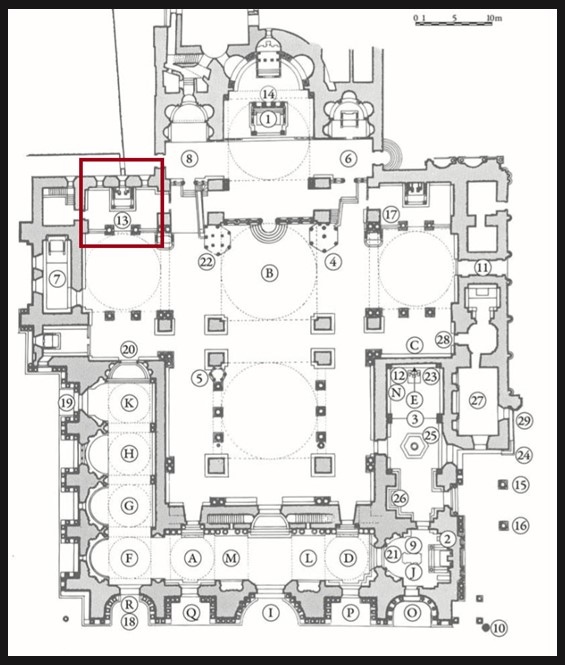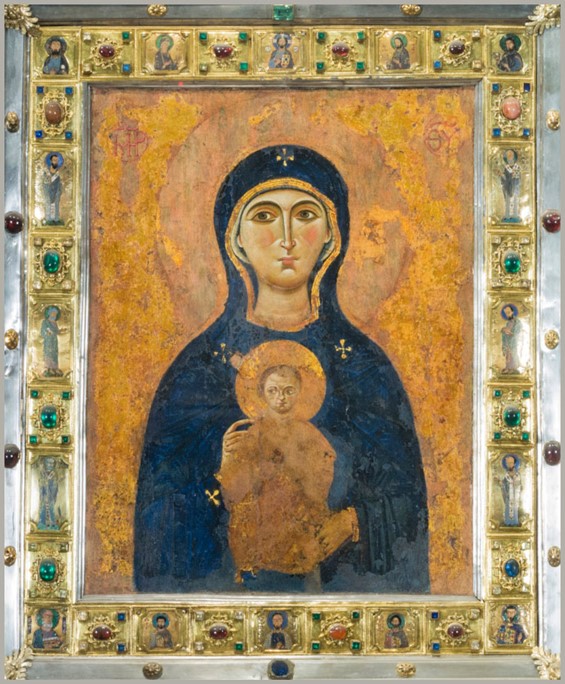
I like how Chrysa A. Maltezou starts her article “Βενετία κι Βυζαντινή Παράδοση – Η Εικόνα της Παναγίας Νικοποιού” (Venice and the Byzantine Legacy – The Byzantine Icon of Panagia Nikopoiou). Please allow me to paraphrase… It was May of 1797, the army of Napoleon Bonaparte was at Venice’s doorstep, the end of the Venetian Republic was fast approaching and the citizens of La Serenissima were desperate… Their hopes rested on divine intervention and like the Byzantines, a centuries-old memory, the Comnenian Icon of Panagia Nikopoiou, Venice’s Palladium, was placed on public veneration at San Marco’s Basilica…It is only interesting to contemplate how the Venetians, hoping for salvation and victory remembered their ties to the long-lost Empire of Byzantium and its Legacy! https://ejournals.epublishing.ekt.gr/index.php/bz/article/view/3570/3430
Tradition links the Icon of Panagia Nikopoiou to Constantinople and the fateful days of the Fourth Crusade, when according to Giovanni Battista Ramusio (1485-1557) the Icon of Nikopoiou (Bringer of Victory) abandoned by Alexios Mourtzouflos on the battlefield, was captured by the Crusaders… The barons and the Venetians battered the walls and towers day and night without with various machines, and redoubled the War, conducting many great skirmishes from one area to another; it was in one of these that they valorously acquired the banner of the Tyrant but with much greater joy a panel on which was painted the image of Our Lady, which the Greek Emperors had continuously carried in their exploits since all their hopes for the health and salvation of the Empire rested in it. The Venetians held this image dear above all other riches and jewels that they took, and today it is venerated with great reverence and devotion here in the church of San Marco, and it is one that is carried in procession during times of War and plaque, and to pray for rain and good weather… https://www.pallasweb.com/deesis/nicopeia-icon-san-marco-loot-from-constantinople-1204-crusade
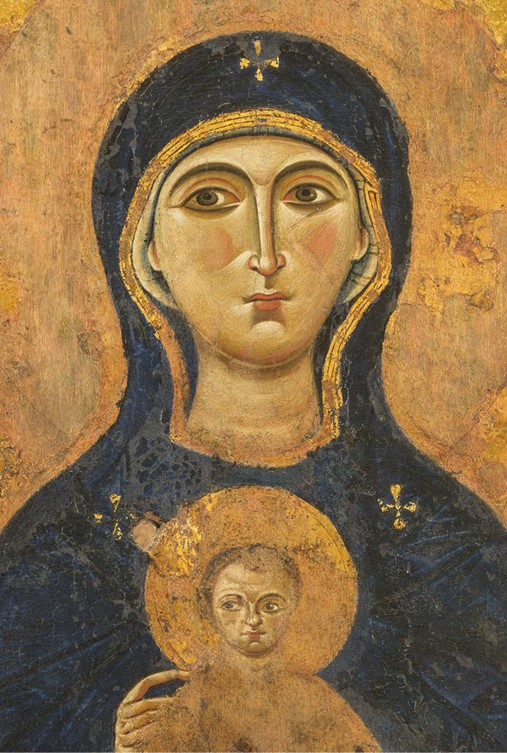
It has been debated, since 1821, whether the Icon of Panagia Nikopoiou, as Nikitas Choniatis mentions in his Χρονική Διήγησις with one brief sentence …ητηςθεομήτοροςεικών, ήνοιβασιλείςΡωμαίωνποιούνταισυστράτηγον, τοῖς ἐναντίοις ἑάλωκεν… is the same Icon Emperor Alexios Mourtzouflos abandoned on the Walls of Constantinople. Giovanni Battista Ramusio thinks so, and writes about it, establishing a tradition that still keeps strong… http://users.uoa.gr/~nektar/history/tributes/byzantine_historians/nicetas_choniates_historia.htm and https://ejournals.epublishing.ekt.gr/index.php/bz/article/view/3570/3430
The Icon itself, presenting Mary holding the Child before Her, is a wonderful work of Art… a fine example of Byzantine iconography. Stark and imposing, it has a compelling effect on me every time I visit San Marco to pay my respects. Conserved in the left transept of the great Basilica, in a chapel of the same name, the Icon of the Virgin was once covered with precious jewels, diamonds, and pearls, now exhibited in the Treasury, following theft and later recovery.
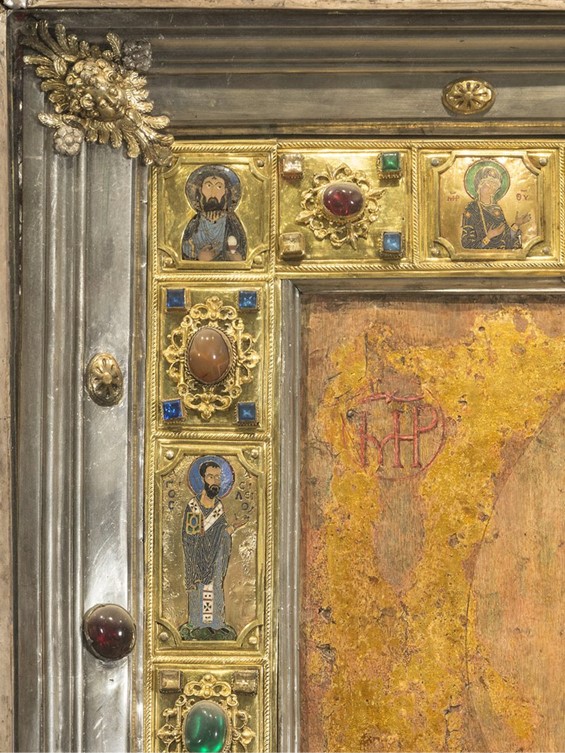
Today, the Icon is enhanced by its Byzantine frame of gilded silver with gold enamels, pearls, and gemstones, of great beauty. The best-preserved part of the Icon is the face of the Virgin, oval in shape, with thick, arched eyebrows, a definite trait of beauty, large eyes, looking slightly to the left, a long nose, and small lips. It is not firmly established when and by whom this amazing Icon was painted. I can only say that it displays extreme delicacy and refinement in the painter’s technique. https://www.pallasweb.com/deesis/nicopeia-icon-san-marco-loot-from-constantinople-1204-crusade
For a Student Activity, please… Check HERE!
